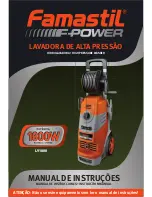
9 — ENG
OPERATION
BASIC ELEMENTS OF A PRESSURE
WASHER
High Pressure Pump
: Increases the pressure of the
water supply.
Engine:
Drives the high pressure pump.
High Pressure Hose:
Carries the pressurized water
from the pump to the gun and wand.
Spray Gun:
Connects with wand to control water
flow rate, direction, and pressure.
Wand:
Multi-Reg wand:
Has a spray nozzle which adjust
from a pencil stream (0°) to a wide angle fan spray
(60°). The spray can be adjusted by twisting the
nozzle clockwise and/or counterclockwise. Also,
the high and low pressure settings can be con-
trolled by moving the nozzle in and out. See
Operation section.
Quick Connect:
This type of lance is equipped
with a female quick connect coupler on the end.
This allows the user to quickly change out high-
pressure nozzles for different spray patterns and
change to the soap nozzle for low pressure and
chemical/soap applications. See Operation sec-
tion.
Chemical Hose:
Allows cleaners or cleaning solvents
to be mixed with the pressurized water stream. See
How To Siphon Chemicals/Cleaning Solvents in
Operation section of this manual.
PRESSURE WASHER
TERMINOLOGY
PSI:
Pounds per Square Inch. The unit of measure
for water pressure. Also used for air pressure,
hydraulic pressure, etc.
GPM:
Gallons Per Minute. The unit of measure for
the flow rate of water through the pressure washer.
CU:
Cleaning Units. GPM multiplied by PSI.
PRESSURE WASHER OPERATING
FEATURES
Bypass Mode
During normal operation the water supply is turned
on, engine is running, spray gun trigger is depressed,
and the cold water supply circulates inside the pres-
sure washer pump allowing pump to maintain a safe
operating temperature. When you release spray gun
trigger and engine is still running, you are in bypass
mode.
When unit is in bypass mode, water circulating inside
the pump begins to heat up. If unit is left in bypass
mode for more than two (2) minutes, the water tem-
perature will rise to a dangerous level and damage
internal components of the pump.
If pressure washer is operated without an adequate
water supply or operated for more than two (2) min-
utes without depressing the spray gun trigger, the
pump will overheat and be seriously damaged. Any
damage to pump due to these causes will not be cov-
ered under warranty.
Bypass Mode:
In Bypass Mode, the pump is recircu-
lating water because the trigger of the spray gun is
not pulled.
Chemical Injection:
Feeds cleaning agents into the
pump to mix with the pressurized water and help in
cleaning.
Water Supply:
All pressure washers must have a
source of water. The minimum requirements for a
water supply are 20 PSI and 5 gallons per minute.
Any supply pressure or
delivery rate less than
this will not allow the pressure washer to
operate at its full potential and may cause
damage to the pump.
Chemical Flow Adjustment
Some pumps are equipped with
an adjustable chemical injector
as shown here. Turn the chemi-
cal adjustment knob counter-
clockwise to increase the
amount of chemical used and
clockwise to decrease the
amount of chemical used. If the knob is turned clock-
wise until it stops, the chemical injector will close and
will not draw any chemicals/soaps.
BASIC ELEMENTS OF ENGINE
Choke Control (if equipped):
Opens and closes the
choke valve in carburetor.
Primer Button (if equipped):
Primes carburetor with
fuel.
Throttle Control Lever:
Controls engine speed.
Starter Grip:
Pulling starter grip operates recoil
starter to crank engine.
Fuel Valve Lever (if equipped):
Opens and closes
connection between fuel tank and carburetor.
Engine Switch (if equipped):
Enables and disables
ignition system.






































